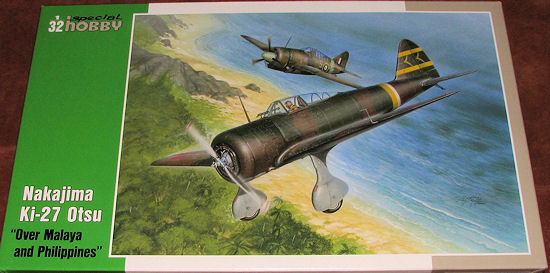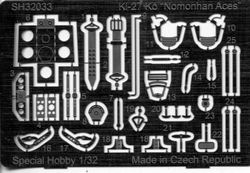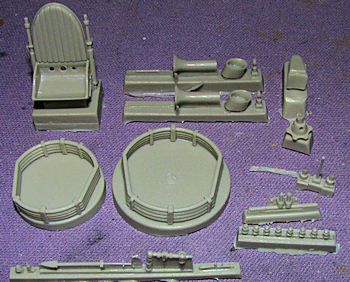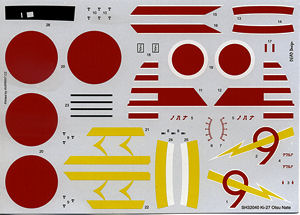
Special Hobby 1/32 Ki-27 Otsu
| KIT #: | SH 32040 |
| PRICE: | $38.99 on sale |
| DECALS: | Three options |
| REVIEWER: | Scott Van Aken |
| NOTES: | 'Over Malaya and Philippines' boxing |

| HISTORY |
The preference of Japanese fighter pilots for the Ki-27's high rate of turn caused the Army to focus excessively on maneuverability, a decision which later handicapped the development of faster and more heavily armed fighters. The Ki-27 served until the beginning of World War II in the Pacific, escorting bombers attacking Malaya, Singapore, Netherlands East Indies, Burma and the Philippines (where it initially fared poorly against the Brewster Buffalo).
The type also saw extensive action against the American Volunteer Group in the early months of the war. Soon outclassed by the American Curtiss P-40 Warhawks, the Ki-27 was replaced in front line service by the Nakajima Ki-43, while surviving examples continued to serve as a trainer.
The Ki-27 was also exported for use with Manchukuo and Thai armed forces, seeing combat with both. In Thai service, Ki-27s reportedly damaged two North American P-51 Mustangs and shot down one Lockheed P-38 Lightning.
In the final months of the war, desperate lack of aircraft forced the Japanese to utilize all available machines, and the Ki-27 and 79 were no exception. Some were equipped with up to 500 kg (1,100 lb) of explosives for kamikaze attacks, but some were redeployed as fighters, suffering terrible losses as on 16 February 1945 when the 39th Educational Flight Regiment scrambled 16 Ki-79 trainers from Yokoshiba Airfield to oppose a massive air raid from U.S. Task Force 58 carrier group, losing six aircraft with more damaged and five pilots killed, in return damaging at least one Hellcat and possibly downing a second.
| THE KIT |
 This
is one of a growing number of Special Hobby/MPM/Azur 1/32 scale kits and so far,
it seems like they have been mostly concentrating on aircraft that flew early in
WWII. As with all of their near-short run kits, the external detailing is very
good. I did note that there is well done internal framework detailing on the
inside of the fuselage halves. There are also some short ejector towers on the
inside of all the large pieces. Some will need to be removed for the parts to
fit. There are a few on the internal fuselage detailing, but you can pretty much
leave them unless you are building for contests.
This
is one of a growing number of Special Hobby/MPM/Azur 1/32 scale kits and so far,
it seems like they have been mostly concentrating on aircraft that flew early in
WWII. As with all of their near-short run kits, the external detailing is very
good. I did note that there is well done internal framework detailing on the
inside of the fuselage halves. There are also some short ejector towers on the
inside of all the large pieces. Some will need to be removed for the parts to
fit. There are a few on the internal fuselage detailing, but you can pretty much
leave them unless you are building for contests.
 Typical of
these kits, there is a goodly amount of resin and some photo etch. Resin is used
for a lot of very small details as well as the pilot's seat, the oil cooler
radiators that run inside the front of the cowlings, carb intakes, head rest,
exhaust stacks and a few other interior bits. The photo etch fret has the seat
harness, rudder pedals, and other interior bits for the floor and the sidewall.
Both the resin and photo etch are superbly done.
Typical of
these kits, there is a goodly amount of resin and some photo etch. Resin is used
for a lot of very small details as well as the pilot's seat, the oil cooler
radiators that run inside the front of the cowlings, carb intakes, head rest,
exhaust stacks and a few other interior bits. The photo etch fret has the seat
harness, rudder pedals, and other interior bits for the floor and the sidewall.
Both the resin and photo etch are superbly done.
The rest of the kit is quite straight-forward. There is a ton of detail for the interior, thanks to the p.e. and etched bits. Both of
the guns are provided with their detail bits. The rudder pedals are several
pieces and there are the nicely done instrument panels with etched handles. Main
panel is raised detail with dial details so careful painting will bring this
out. As mentioned, there are bits that fit to the sidewall such as the throttle
quadrant, map holder and other pieces.
is a ton of detail for the interior, thanks to the p.e. and etched bits. Both of
the guns are provided with their detail bits. The rudder pedals are several
pieces and there are the nicely done instrument panels with etched handles. Main
panel is raised detail with dial details so careful painting will bring this
out. As mentioned, there are bits that fit to the sidewall such as the throttle
quadrant, map holder and other pieces.
The engine is also nicely done and there is where several
people might look askance on the kit. You see, you have to make all 18 of the 10
mm push rods out of 0.3mm stock. The kit includes two under wing fuel tanks and
the attachment points are small resin bits. I think most of us will not bother
with these. The landing gear seems overly engineered as the gear spats are in
four pieces, an upper and a lower section. I think they could have done these in
just two halves. You have the option of removing the position lights and
replacing them with little clear bits if you so desire. The clear bits are
nicely molded and the canopy is a separate item so you can pose that open if the
plastic is thin enough. There is a gun sight that fits through the windscreen
and from th e
look of things you have to drill out a notch in the windscreen so that sight
mount can be installed. At least that is how it seems. The instructions are not
very clear on this (no pun intended).
e
look of things you have to drill out a notch in the windscreen so that sight
mount can be installed. At least that is how it seems. The instructions are not
very clear on this (no pun intended).
Markings are for three aircraft. One is the box art plane from the 77th Sentai in brown and green over ash grey from Malaya in 1942. Another is a similarly painted plane, but with indigo blue added to the upper surface camo scheme. This one is from the 24th Sentai during the Philippine invasion of December 1941. The third option is one in dark green over ash grey with the 50th Sentai. It is listed as based at Clark Field in January 1942. It sports yellow wing ID bands. I have to say the instructions probably got the date wrong as according to Thorpe, the yellow wing ID bands did not come into use until 1943 when the Japanese were on the defensive.
| CONCLUSIONS |
Aside from the rather irritating requirement to provide your own push-rod housings, something that should be supplied, this looks like a pretty straight-forward and relatively easy to complete kit. There are two build articles in the archives on this one and both reviewers seemed to have no real trouble building it. It has a lot of cockpit detail and is well worth having the canopy open, but even if kept closed, the clear bits will allow all your work to be seen.
| REFERENCES |
http://en.wikipedia.org/wiki/Ki-27
January 2013
Thanks to me for spotting this one on sale.
If you would like your product reviewed fairly and fairly quickly, please contact the editor or see other details in the Note to Contributors.